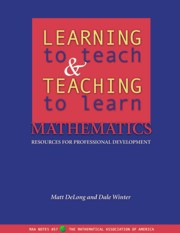Book contents
- Frontmatter
- Preface
- Contents
- 1 The Professional Development Program
- 2 How to Use this Book
- 3 An Orientation Session for the Beginning of the Semester
- 4 Making In-class Groups Work
- 5 Getting Students to Read the Textbook
- 6 Assessing and Evaluating Students' Work
- 7 Managing Homework Teams
- 8 Teaching During Office Hours
- 9 Establishing and Maintaining Control in Your Classroom
- 10 Proctoring Tests and Examinations
- 11 Teaching with Calculators and Computers
- 12 Making Lesson Plans
- 13 Strategies for Motivating Students
- 14 Dealing With Difficult Instructor-Student Situations
- 15 End-of-Semester Administration
- 16 Adapting Materials and Designing Your Own Meetings
- 17 Classroom Visits
- A Tips for Running Meetings
- B The Michigan Introductory Program
- Bibliography
6 - Assessing and Evaluating Students' Work
- Frontmatter
- Preface
- Contents
- 1 The Professional Development Program
- 2 How to Use this Book
- 3 An Orientation Session for the Beginning of the Semester
- 4 Making In-class Groups Work
- 5 Getting Students to Read the Textbook
- 6 Assessing and Evaluating Students' Work
- 7 Managing Homework Teams
- 8 Teaching During Office Hours
- 9 Establishing and Maintaining Control in Your Classroom
- 10 Proctoring Tests and Examinations
- 11 Teaching with Calculators and Computers
- 12 Making Lesson Plans
- 13 Strategies for Motivating Students
- 14 Dealing With Difficult Instructor-Student Situations
- 15 End-of-Semester Administration
- 16 Adapting Materials and Designing Your Own Meetings
- 17 Classroom Visits
- A Tips for Running Meetings
- B The Michigan Introductory Program
- Bibliography
Summary
The mathematics course that we envision utilizes a variety of assessment techniques, including team home- work, projects, student presentations and writing assignments. A common element of these assessment practices is the clear and precise communication of mathematical ideas.
In many cases, students are expected to work cooperatively – to produce a single piece of work representing the collective efforts of three or four students. In order to provide sufficient challenge for a group of students and sufficient incentive for the students to work cooperatively (instead of simply dividing the work among themselves, and later compiling their individual contributions for submission) the problems assigned are more complicated, and are sometimes more “open-ended” than exercises typically assigned in traditional mathematics classes. The problems assigned typically require students to make appropriate assumptions, to try alternative avenues of inquiry, to try to understand the mathematics more thoroughly by recognizing its application to otherwise unfamiliar situations, etc.
The work that students produce on these more complicated assignments is not simply pages of algebraic manipulations with boxed answers at the end. Instead, students are encouraged (and helped) to exhibit their understanding of the mathematics in multiple ways (such as graphs, written accounts of their assumptions and reasoning processes), instead of simply recording the algebraic steps that they performed.
As may be expected, assessing and grading student work of this kind can be radically different from assessing and grading pages of algebraic manipulations with a conveniently highlighted answer at the end.
- Type
- Chapter
- Information
- Learning to Teach and Teaching to Learn MathematicsResources for Professional Development, pp. 65 - 88Publisher: Mathematical Association of AmericaPrint publication year: 2002

